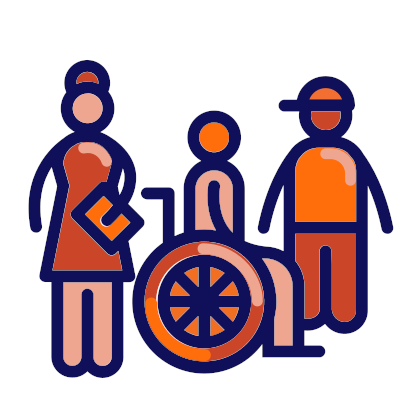Preventing bullying and violence

Schools can, and should, play a key role in tackling these abuses.
Whole-school anti-bullying programmes are needed, which promote peer support systems and involve active and well-trained teachers and parents, to foster a safe learning environment in which no violence is allowed.
Facts & figures
Half of the world’s students aged 13-15 say they have experienced violence in and around school.[1]
Nearly one in three students of this age say they have experienced bullying or been involved in fights.[2]
More than 700 million children have no legal protection from corporal punishment at school.[3]
What is violence and bullying?
Violence is the threatened or actual use of physical force or power resulting in physical or psychological harm to others.
Bullying is a form of violence. It can be defined as unwanted, aggressive behaviour which involves a real or perceived imbalance of power. It is behaviour that is repeated, or carries the threat of being repeated over time.
Bullying takes different forms in school, including:
- Physical, e.g., hitting, kicking, slapping, shoving, hair-pulling, etc.
- Verbal, e.g., name-calling, teasing, using belittling expressions, etc.
- Relational, e.g., ostracising, spreading rumours, social manipulation, etc.
- Sexual, e.g., sexual name-calling, uninvited touching, propositioning, etc.
Cyberbullying is a distinctive form of bullying. It differs from other types on account of the constant risk of public exposure, the complex roles of observers and the size of the audience that comes with digital technologies.[4].
Bullying is not the only form of student-on-student violence in schools, however. Fights between, and attacks on students associated with gang culture and the carrying of weapons, especially knives, are becoming an increasing problem in various countries.
Why is addressing violence and bullying important at school?
Under the U.N. Convention on the Rights of the Child, schools have a formal duty to protect children from all forms of violence, both physical and psychological.
“Parties shall take all appropriate legislative, administrative, social and educational measures to protect the child from all forms of physical or mental violence, injury or abuse, neglect or negligent treatment, maltreatment or exploitation, including sexual abuse, while in the care of parent(s), legal guardian(s) or any other person who has the care of the child.”[5]
Failure to protect children at school can have harmful repercussions on their future lives, both educationally and socially - whether they be victims, perpetrators or bystanders.
Students who are bullied are more likely to suffer from depression and anxiety, health issues, poor academic achievement and behaviour problems at school, including higher drop-out rates. A small number may also retaliate in violent ways. Students who bully others are more likely to exhibit other behaviour problems at school and to suffer from alcohol or drug abuse, and to engage in criminal activity and abusive relationships in adulthood. Children who witness bullying and violence are also more likely to have mental health difficulties and miss or drop out from school.
Violence and bullying not only affects academic learning, it also impacts negatively on the social development of young people. In particular, students who experience violence and bullying are more likely to have difficulty developing basic democratic competences, such as empathy, respect for others, openness to other cultures and beliefs, tolerance of ambiguity and self-efficacy – all of which lie at the heart of the Council of Europe Reference Framework of Competences for Democratic Culture.
The effects of violence and bullying are not limited only to the students directly involved, but potentially impact on everyone at a school. Unchecked, incidents of violence and bullying lead to an atmosphere of anxiety and insecurity incompatible with learning. They also lead to, or exacerbate conflicts beyond the school gates, which in turn have further consequences for relations within the school.
What are the challenges?
Violence and bullying can be challenging to deal with at school. What is regarded as bullying or violence is sometimes thought of as a matter of subjective opinion. It can be difficult to build a common approach to eradicating from school something which a significant proportion of staff believes not to exist or is not important to them.
The prevailing culture in a school can sometimes work against attempts to reduce violence in its different forms. Rule by fear, over-emphasis on punishment and the prioritization of learning environments which support competitive behaviour all militate against the prevention of violence and bullying. So, too, does the holding of an ideology which accepts violence as a valid response in situations of fear, stress or frustration – as evidenced in the advice commonly given to victims of bullying to fight back and give the bully a ‘taste of their own medicine.’
In such circumstances it can be easy to think that dealing with violence and bullying is simply a matter of stopping fights, giving punishments and imposing order, rather than questioning the wider culture of the school, the examples it sets and the sorts of behaviour it supports.
Many teachers are unaware of democratic approaches of dealing with violence and bullying, such as:
- restorative justice
- conflict resolution
- peer mediation.
Such approaches are not only arguably more effective than punitive ones, but also have the advantage of promoting democratic values and attitudes more widely across a school.
Such approaches take time to learn, however, and require the development of specific types of skills, knowledge and attitudes. They also take time to put into practice. It can be difficult for a teacher to find the time and motivation to deal with violence and bullying in a democratic and constructive way. It is easier just to punish the supposed perpetrator, and easier still to pass the perpetrator up the school hierarchy for a more senior member of staff to punish.
A further challenge in recent years has been the rise of gang culture among young people and the carrying of weapons, especially knives, in as well as out of school. This has led to a rise in the number of serious acts of violence between students and also to the more regular involvement of the police in school affairs, both of which demand new professional skills and ways of working from teachers and school leaders.
How can schools get active?
Taking action on violence and bullying is not just a matter of finding better ways of responding to incidents after they have occurred – though this is important, but also of creating the kind of school environment in which violent incidents are less likely to happen in the first place.
A good place to start is with asking students to review the current situation in their school:
- where they feel vulnerable or in danger
- where they feel safe
- what sorts of violence they have witnessed or experienced
- what they see as the causes of these sorts of violence
- how effective they think the school is at dealing with violence
- what further measures they would like the school to take.
Surveying student opinion provides a good evidence base for targeting measures to prevent violence, e.g., increasing supervision in areas in school where students are fearful of going, creating more opportunities for constructive play during breaks from lessons, etc.
It can also stimulate a whole-school conversation about violence and bullying. Such a conversation is important for arriving at a whole-school policy that everyone can support. It is an opportunity to develop a common language and understanding of what constitutes violence and bullying in school and shared rules on how to approach it, including the reporting and monitoring of incidents. This is why it is essential that the voices of all school stakeholders are heard in the process of policy-development: principals, teachers, students, parents and the local community.
The conversation should also include the opportunity for teachers to reflect on practices that lead to frustration and low self-esteem among students, such as an over-emphasis on competition, over-frequent assessment and unreasonably high expectations of academic attainment. Attention should be given instead to creating a school environment which encourages inclusion and co-operation, and the valuing of individual differences and diversity.
Reflection on current practice goes hand in hand with the provision of opportunities for school staff to develop new skills. The ability to recognise violence in all its forms and to be able to deal with it appropriately are important professional skills for any adult involved in school life.
As young people themselves are often the most effective agents for change in a school, it is important they should be involved in formal initiatives to reduce violence and bullying, such as peer mediation schemes. Such schemes are most effective when taken seriously by both staff and the students involved, for example, by instituting formal recruitment procedures for student mediators and opportunities for high-level training from someone with the appropriate professional expertise.
Initiatives of this kind can be supported in the classroom by making time in the curriculum to talk with students about issues of violence and bullying. It should include discussions about the psychology of bullying, the effects of peer pressure and the influence of social media on young people’s behaviour.
[1] UNICEF Report, September 2018
[4] de Morais & Fernandes, 2017. ‘When bullying crossleakes the screen’. In J. Richardson, E. Milovidov & R. Blamire (Eds.), Bullying: Perspectives, Practices and Insights (pp. 11-16). Strasbourg, France: Council of Europe.
 Resources on Preventing violence and bullying
Resources on Preventing violence and bullying
 Related schools projects
Related schools projects
Address: Rua da Guiné - Bairro dos CTT, 1675-468 Caneças
Country: Portugal
Project: Digital Citizenship Education for Democratic Participation
 Working language during the project:
Working language during the project:
- Portuguese
 Themes of the Council of Europe campaign “FREE to SPEAK, SAFE to LEARN - Democratic Schools for All” covered:
Themes of the Council of Europe campaign “FREE to SPEAK, SAFE to LEARN - Democratic Schools for All” covered:
- Making children’s and students’ voices heard
- Addressing controversial issues
- Preventing violence and bullying
- Dealing with propaganda, misinformation and fake news
- Tackling discrimination
- Improving well-being at school
 Competences from the Reference Framework of Competences for Democratic Culture (CDC) addressed and where / how they were integrated:
Competences from the Reference Framework of Competences for Democratic Culture (CDC) addressed and where / how they were integrated:
- Linguistic, communicative and plurilingual skills and Knowledge and critical understanding of language and communication
Through the production of a school newspaper (printed since 2016, and online in 2020), and the production of TV news services (since 2018) - Knowledge and critical understanding of the world: politics, law, human rights, culture, cultures, religions, history, media, economies, environment, sustainability
Apart from communication, the project is now focused on problem-based learning through STEAM activities (focused on preschool children). Developed activities aimed building multiple literacies, citizenship, analytical and critical thinking, resilience and creative thinking. - Co-operation skills
Activities (planned by teachers and researchers, having in mind the children interests) involve school staff, parents, other relatives and members/entities from the local community.
 Target group age range:
Target group age range:
- 5 - 11
 Level of education:
Level of education:
- Primary education & Preschool education
Short description of the project:
The project Digital Citizenship Education for Democratic Participation (‘Educação para a Cidadania Digital e Participação Democrática’) began in 2015, and currently involves around 200 kindergarten and primary school children, their families, teachers and other members of the Caneças educational community, a neighbourhood in Odivelas, Lisbon. The project’s methodology is action research, its objective is to understand how a coordinated action by a school, families and the community contributes to enabling 3- to 9-year old children to become active digital citizens.
From 2015 to 2018, at the field level, the project was organised in five phases:
- Production and validation of data collection instruments (2015);
- In-service teacher training course in Digital Citizenship Education (Jan-Feb 2016);
- Longitudinal study with teachers who volunteered after the training course (Mar 2016-Feb 2018);
- Data collection from parents, children and out-of-school entities (Apr-Jun 2016);
- Share results with participants and involve them on a digital citizenship education intervention plan (Sep 2016-Feb 2018).
Between January and February 2016, the researchers conducted a training course for the teachers on using media to organise and implement social participation activities, involving pupils, families and the community.Afterwards, eight teachers in a school in Caneças, attended by about 200 kindergarten and primary school pupils, accepted to be part of a community intervention project. Researchers characterize this context so as to define an intervention strategy.
In September 2016, at a meeting between lecturers and researchers, it was decided to create a printed school newspaper with four main goals in mind: i) reinforce the link between the school, the families and the community; ii) ensure that children have the opportunity to express their opinion through the media; iii) reinforce their critical sense in relation to the media and to social issues; iv) foster democracy at school and in the community.
Aware of the contradiction of having a project on Education for Media Citizenship based on traditional printed media, the project team nevertheless decided to implement the project, as this was the only way to overcome the limitations of its context. The first step was to select the name and logo for the newspaper by means of a contest, open to all pupils. The name most voted was ‘O Cusco’ (The Busybody). The first edition was published in December 2016, and the next (8th) edition will be published in December 2020.
It had two main outcomes. On the one hand, it increased children’s participation and social intervention, thus contributing to the development of their citizenship skills. On the other, it became a sustainable project, taken on by the school, which has continued to develop digital citizenship skills, by continuing to publish the school newspaper, nowadays considered the newspaper of the school and educational community, where it is distributed for free.
Children’s social participation has increased in and outside the school, in collaboration with the teachers, the families and the community. According to the teachers’ perceptions, interaction in formal, non-formal and informal contexts has contributed to shaping the children’s practices as citizens. However, they participate mostly through traditional printed media, which has gradually changed to digital media, with the production of a video news broadcast.
This situation can be explained due to the lack of equipment and to teachers’ limited skills in digital media production. To overcome this problem, a new phase (Oct 2019 – Sept 2022), funded by Calouste Gulbenkian Foundation, is being implemented, aiming to develop STEAM activities, to implement the online newspaper edition and the production of TV News services. It involves the local government, the school grouping and a private university in Lisbon.
 Aims/objectives
Aims/objectives
The project’s main objective was to understand how coordinated action by a school, families and the community, contributes to enabling 3 to 9-year-old children to become active digital citizens. It also aimed to contribute to identifying best practices in all contexts, to influence public policies, and to integrate digital citizenship education in the curricula. Finally, it was intended to be replicable in Portugal or abroad.
Objectives of the new phase (2019-2022) are focused on the development of competences related to communication and problem solving.
 Expected results/outcomes
Expected results/outcomes
Empowering digital citizens at preschool and primary school levels and involving the local community, implementing a “whole school approach” strategy.
 Changes
Changes
Children’s social participation has increased in and outside the school, in collaboration with the teachers, the families and the community. According to the teachers’ perceptions, interaction in formal, non-formal and informal contexts has contributed to shaping the children’s practices as citizens.
 Challenges you faced
Challenges you faced
Therefore, although adults and children are active and frequent users of digital media, this does not mean that they are ready to produce (more complex forms of) media content. Even when producing material for traditional media, for the newspaper to become a reality, it was crucial that the intervention methodology was action research, with support given to the teachers by the researchers. This is evidence that these kinds of projects must include frequent and significant support provided to the schools or institutions they are being developed in.
The projects must also have the support of the Group’s School board (Agrupamento de Escolas), which was essential in this case. At least one teacher must coordinate the project in the school (in this case, it was the school coordinator) and, if possible, one media professional should be included, who can assist teachers and pupils in producing media content, as was the case in this project. Moreover, this project is not complete, as a second stage is necessary that will involve more researchers and media professionals who can train children to deconstruct and analyse media content, as well as produce content with consideration given to the adequacy of the techniques and ethical and deontological aspects.
 Time-frame of the project:
Time-frame of the project:
2015-2022
 Council of Europe materials on citizenship and human rights education used while preparing or implementing your practice:
Council of Europe materials on citizenship and human rights education used while preparing or implementing your practice:
- Reference Framework of Competences for Democratic Culture
- Compass
- Compasito







